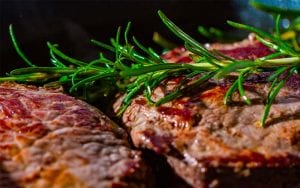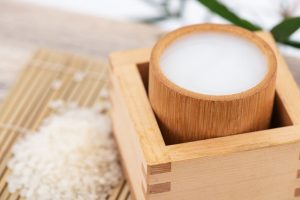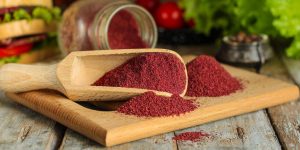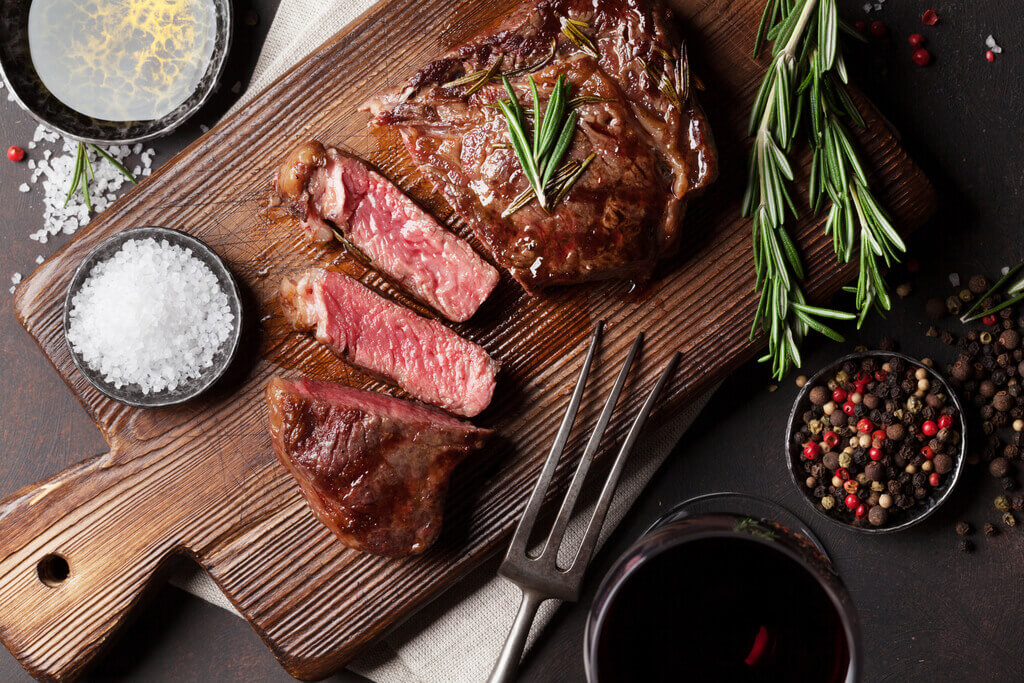
If a special occasion is coming up, you might be planning on serving some extravagant steak recipes for dinner. The perfect steak, as they say, starts with the right cut. You might have headed to the nearest butcher shop to look for the best cut of steak, but found that there are too many options. Worry no more as we will demystify the vast world of steaks just for you!
Before you settle on the most expensive meat, thinking it is the best cut, think twice. It pays to know more about the different types of steak first. Each beef cut varies in terms of shape, flavors, texture, marbling, and more. Some are the perfect cuts for your sizzling steak fajitas, and some are destined for grilling. And so here are the best steak cuts that are hands down cut above the rest, plus how to best enjoy them.
What Is the Best Cut of Steak?
Steaks are not created equal, and that’s a fact. Some cuts yield tender, succulent results, while some are a little tough and chewy. Others boast impeccable texture but lack a beefy palate or the other way around. But without further ado, we present you with the best steak cuts, all of which make for a mouthwatering steak dinner!
Ribeye Steak
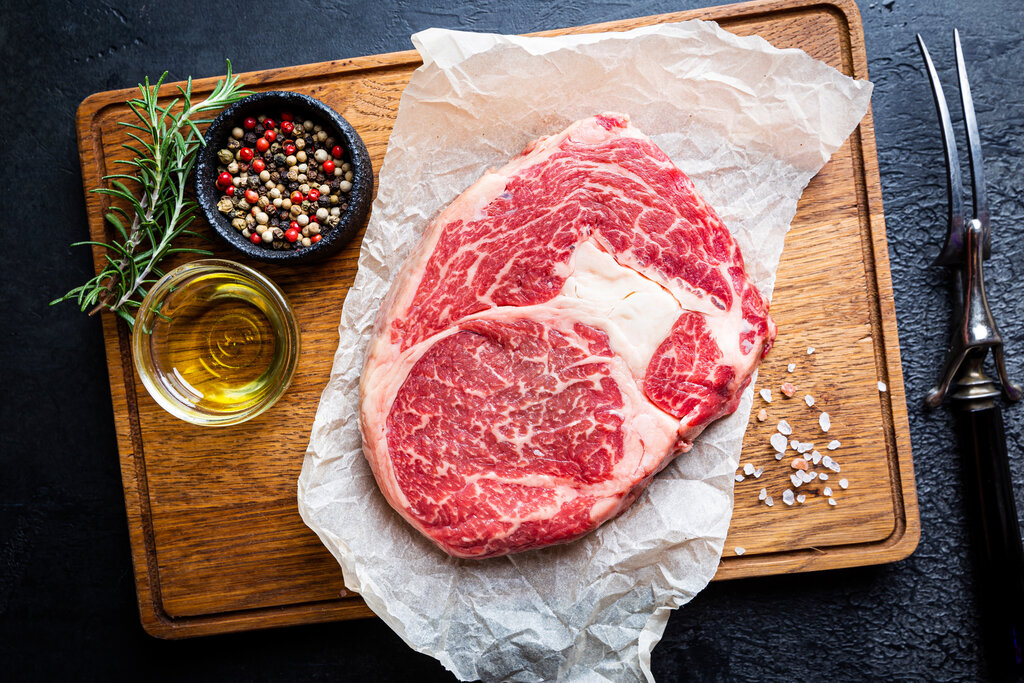
- Juicy, tender, and has lots of marbling
- Best steak cut for grilling
Ribeye steak is a cut found in the cow’s upper rib section. In essence, ribeyes are prime rib roasts that are sliced into individual steaks. Ribeye steaks, which also go by the monikers of Delmonico or beauty, contain a generous amount of marbling. They are also known for being ultimately juicy and downright tender, with a deep beefy flavor. No wonder they are amongst the best-tasting steaks.
While they are usually sold boneless, there are also bone-in ribeyes available in the market. Although the bone lends flavors and moisture, bone-in ribeyes might be daunting to cook.
In general, however, a ribeye beef cut is the best steak to grill. It is super fatty so it will remain juicy, all with that delicious dark char from grilling. Plus, these steak cuts are thick enough and tough to overcook even on high heat (which is required when grilling meat).
Tenderloin Steak
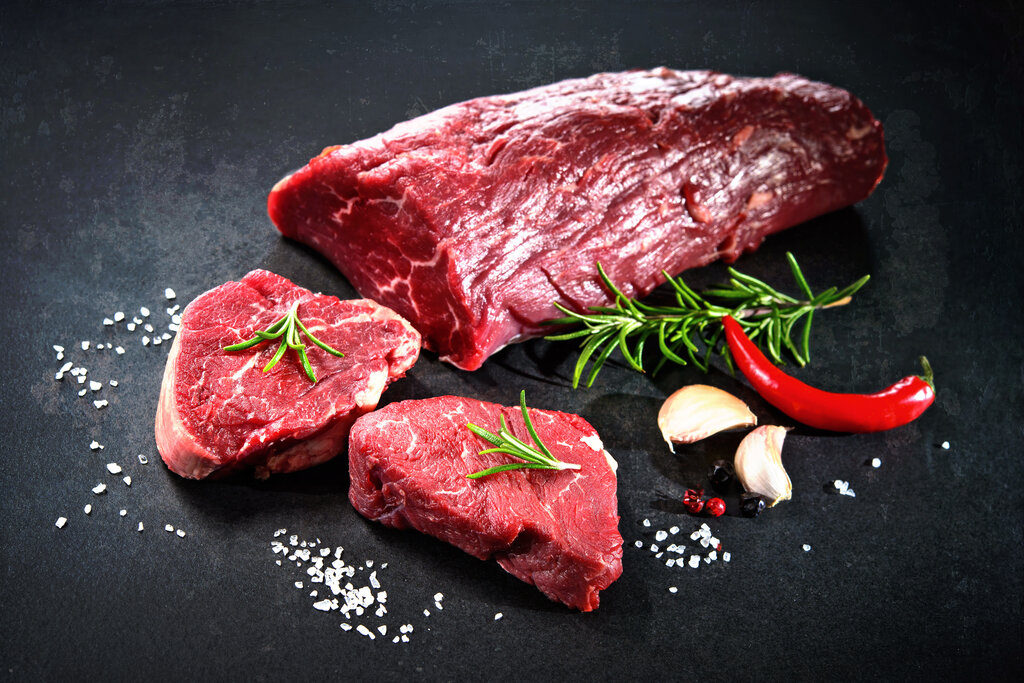
- The most tender cut of steak
- Among the most expensive steaks
The tenderloin comes from the long strip of muscle found in the animal’s short loin (which is located in the cattle’s back), said to be the home of the most tender cuts of beef. That’s because unlike the other parts of the cow, the muscle in this portion is not toughened with too much exercise. Reckoned as the most tender cut of steak and among the most expensive beef cuts, tenderloin has a soft, butter-like tenderness.
Tenderloin steaks, albeit tender, tend to be flavorless. These beef cuts lack marbling and fats, which gives the meat a rich, beefy palate. It is often paired with a flavorful steak sauce, like this delicious cherry port sauce, to compensate for the lack of flavor. Nonetheless, if you wish to bite into this fine, succulent piece of meat, we suggest that you cook it to a medium-rare or medium.
Filet Mignon
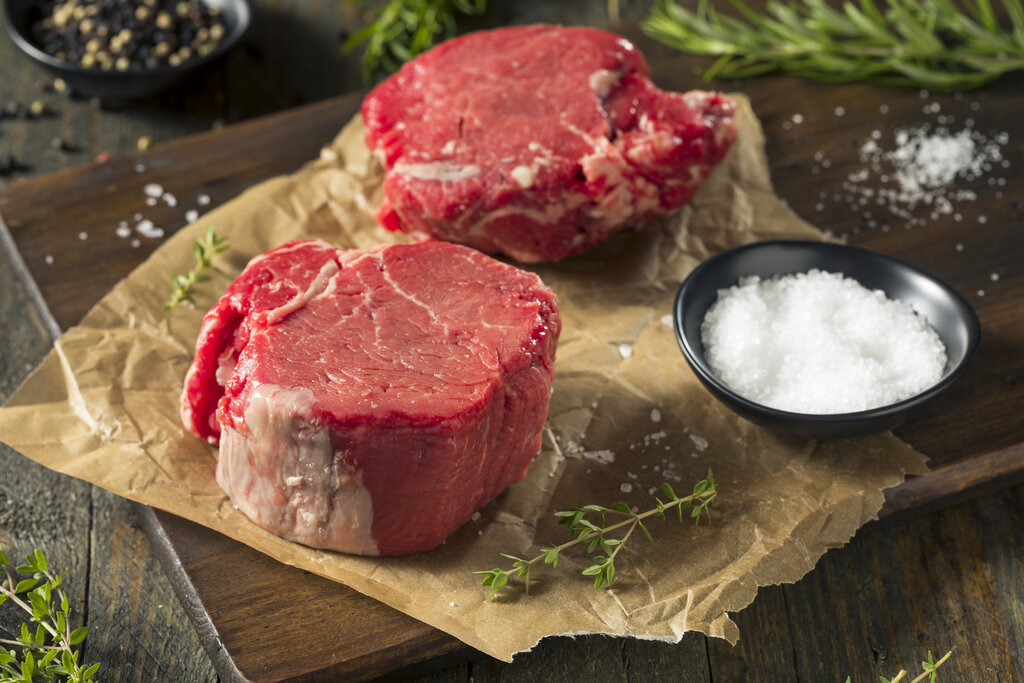
- The most expensive cut of steak
- One of the most tender beef cuts
A French term for strip (filet) and small and pretty (mignon), filet mignon is perhaps the finest and the most expensive cut of beef at that. So, what part of the cow is filet mignon? It is found in the lower part of the cow’s rib, specifically in the middle part of the tenderloin. Meaning, this steak boasts an unparalleled melt-in-your-mouth tenderness.
Filet mignon is often available boneless and sliced in smaller circular portions. After all, this steak always comes in round shapes, being cut from the tube-shaped end of the muscle. When preparing filet mignon, you should remove the white strip of cartilage or the silverskin as it is a tad hard to chew. Filet mignon is also excellent for grilling, broiling, roasting, and pan-frying. Although, make sure not to cook this beef cut beyond medium-rare as longer cooking time makes it drier and less tender.
Hanger Steak
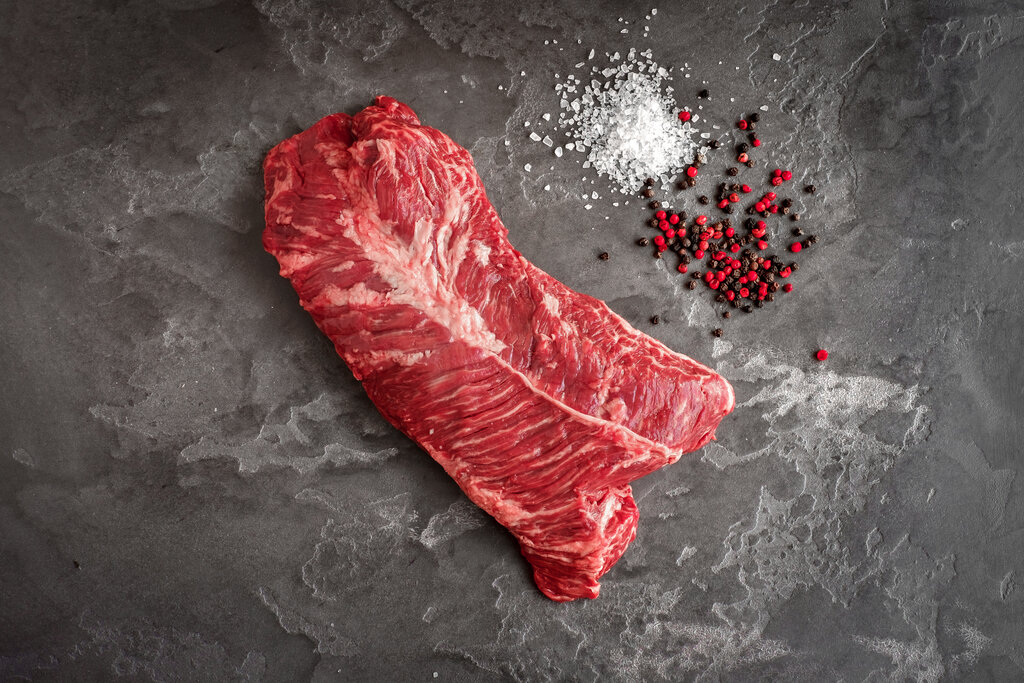
- Tender and full of beefy flavor
- Cheaper than other steak cuts
- Suitable for tacos
Situated in the lower belly of the cow, the hanger steak (or onglet in French) hangs from the diaphragm between the rib and the loin. This steak cut also comes with a V-shaped pair of muscles and a long inedible membrane in the middle.
One of the most underrated steak cuts, hanger steaks are just as tender as the other steaks, more flavorful even. That is why butchers before would not sell the meat cut in the market and would rather keep them for themselves. Hence, its other moniker, the butcher’s steak. Later on, this cut grew popular and is now widely available in the market. The good news is this particular steak cut carries a cheaper price tag than the popular ones.
If you plan on grilling hanger steaks, cook them quickly over high heat. That way, they won’t be too chewy. A flavorful marinade will also help elevate the flavors and tenderize the meat.
Porterhouse Steak
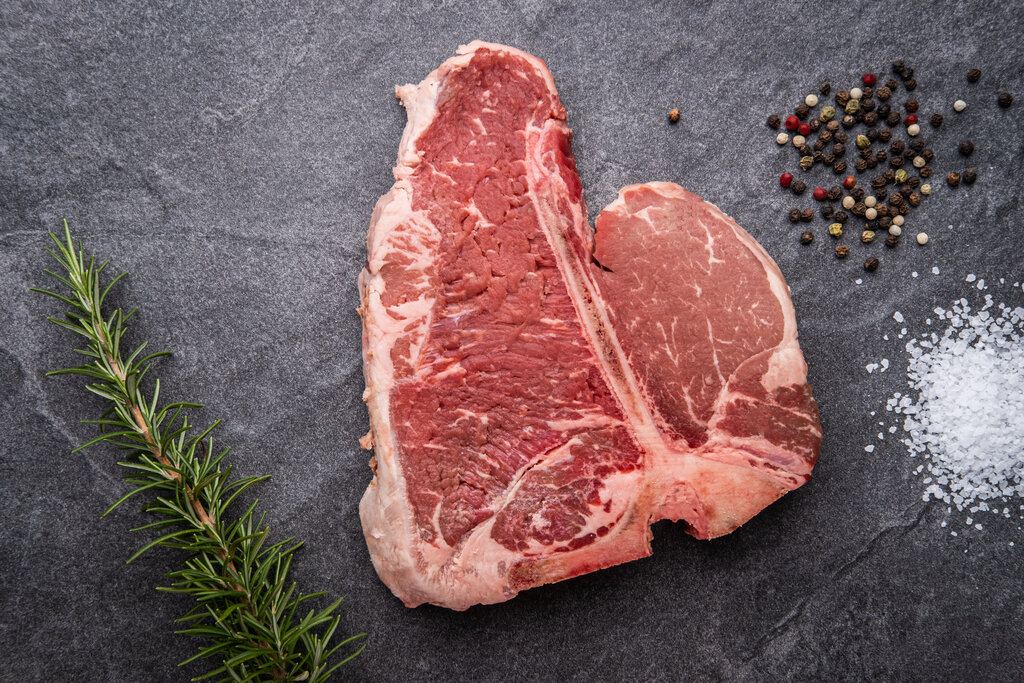
- A combination of tenderloin steak and New York strip steak
- Has a generous amount of marbling
- Has a T-shaped bone
The porterhouse steak, found between the tenderloin and top loin, is a large cut of beef consisting of tenderloin and New York strip steak. Simply remove the T-shaped bone and cut it into two smaller portions to get those two prized cuts: one that is tender (tenderloin) and the other flavorful (strip steak).
Some people often confuse porterhouse for T-bone steak, which is quite understandable given that these two beef cuts have a T-shaped bone. So how can you tell their difference? It is all about the size. Both beef cuts contain tenderloin, but porterhouse steak has a significantly larger section of this tender steak cut. In summary, porterhouse steak is the larger version of the T-bone steak.
A perfect steak for group gatherings, you can cook porterhouse using a broiler, an oven, or a stovetop. Cook this piece of meat over high, dry heat to medium-rare as you would strip steak to enhance its natural taste. We recommend using a meat thermometer to make sure you achieve restaurant-worthy doneness.
T-Bone Steak
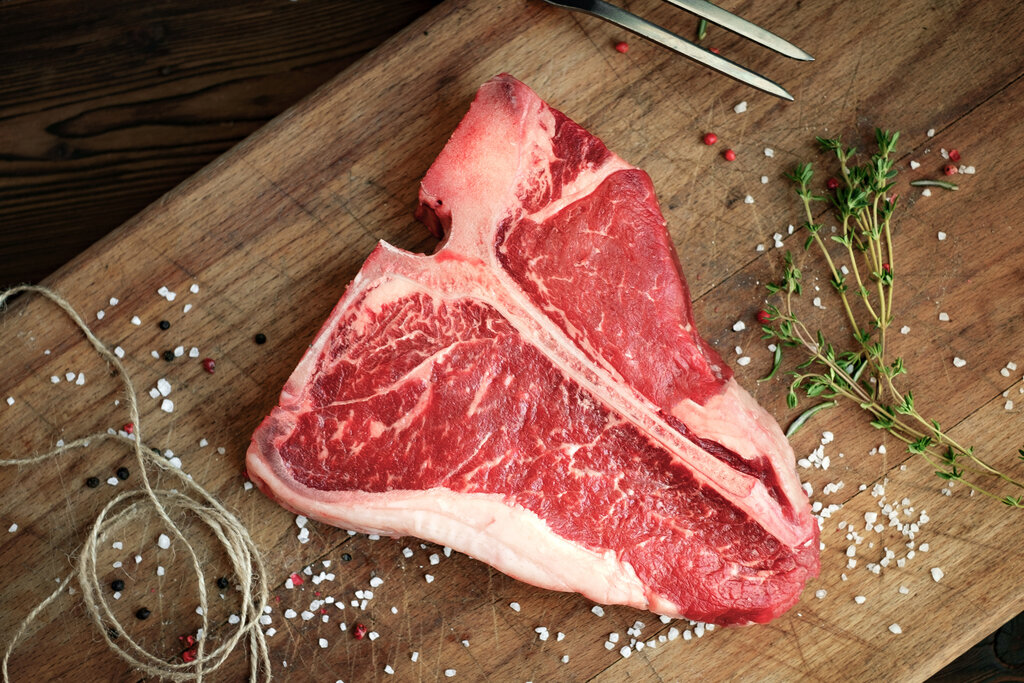
- Has distinctive T-shaped bone
- Also combines two prized steaks
- Has a beefy palate and fine texture
With a distinctive T-shaped bone, a T-bone steak is a crosscut from the forward section of the short loin. Similar to porterhouse, T-bone steaks combine the beefy flavor of strip steak and the buttery texture of tenderloin. Although, it has a smaller portion of the tenderloin as compared to a porterhouse steak.
T-bone steaks, as evident in the name, are always bone-in. Cooking such steaks might be a bit of a chore since it contains two different meat cuts. The trick here is to position the strip steak section closer to the heat. Cooking it from medium-rare to medium will also bring out its succulence right off the bat.
Flat-iron Steak
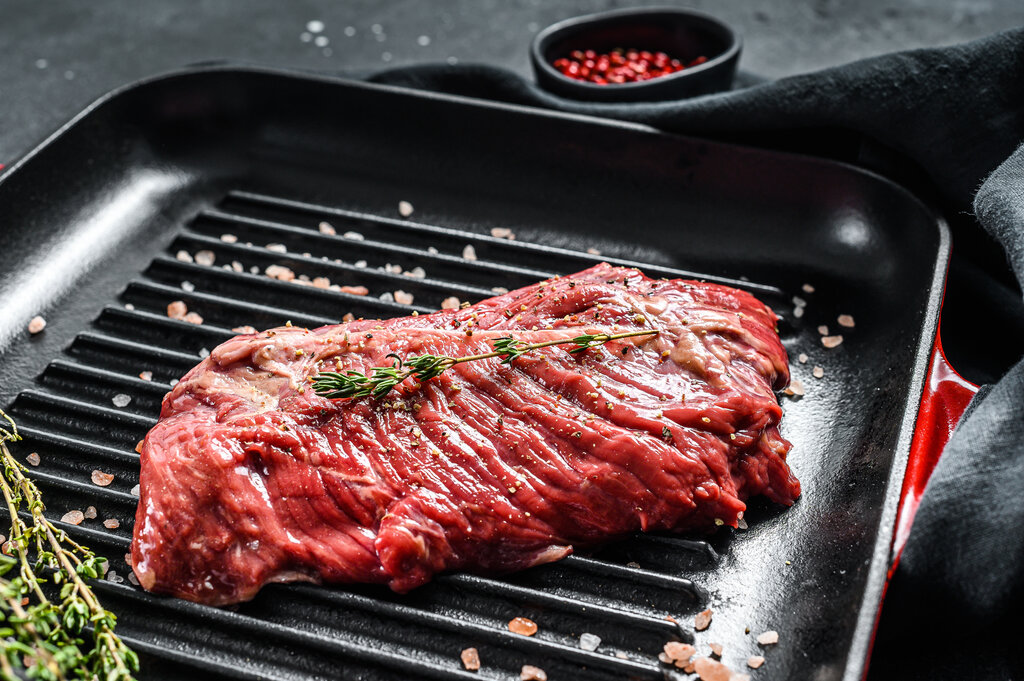
- Tender and has good marbling
- Great for grilling, tacos, and sandwiches
A flat-iron steak is a beef cut located in the shoulder or chuck section of the cow. It is also referred to as top blade steak, top blade filet, and shoulder top blade steak. With a nice amount of marbling, flat-iron steaks aren’t short of deep, beefy flavors. Not to mention, they are almost as tender as tenderloin steaks, especially when cooked the right way. In a nutshell, a flat-iron steak is an affordable alternative to fancy, tender steak cuts.
There are many ways to cook flat-iron steak, but grilling them is the best ticket to release its deliciousness. Even more impressive is there is no need for a marinade to amplify its taste as it is already full of beefy flavors. While it is already succulent grilled on its own, you can also incorporate flat-iron steak in many recipes like tacos and sandwiches.
READ ALSO: Ground Chuck vs Ground Beef: Differences Explained!
Top Sirloin Steak
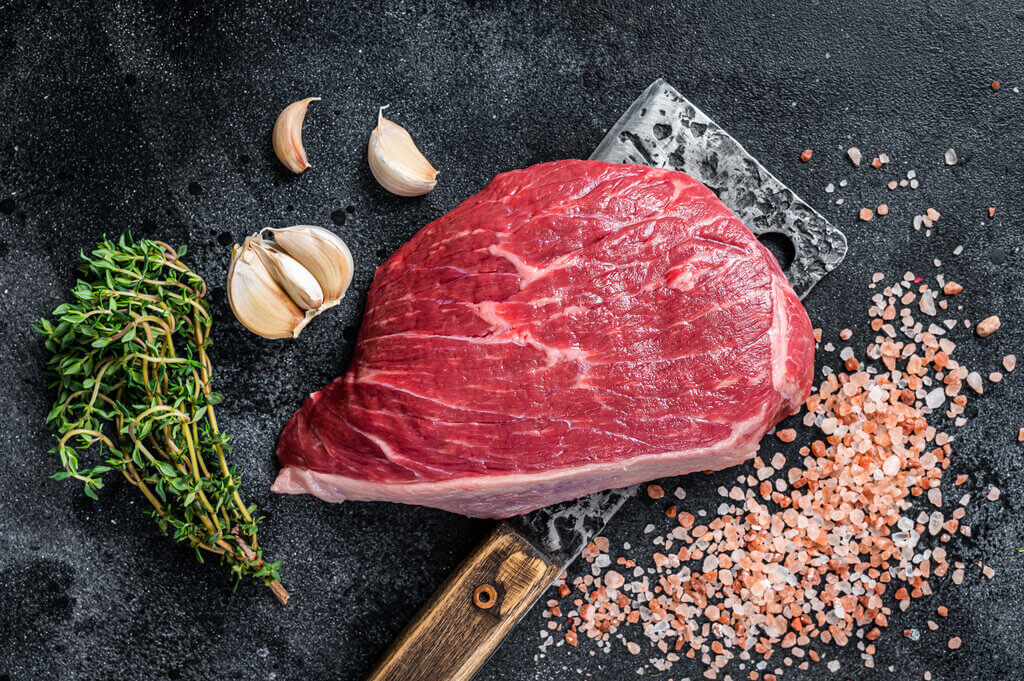
- Has less fat content compared to other steak cuts
- Can be chewy if cooked incorrectly
- Affordable steak cut
Top sirloin beef cuts are located in the top portion of the cow’s hip area, which is among the most active parts of the animal. This being so, this thick beef cut, also referred to as boneless top sirloin steak or top sirloin butt steak, has minimal fat content. Hence, when compared to other steak cuts like a ribeye steak, top sirloin is a bit leaner and less marbled. But what it lacks in tenderness, it makes up for in a rich beefy palate.
To unleash the right balance of flavor and tenderness, cook them on the grill on a rare to medium-rare doneness. Flavor-wise, top sirloin can be on par with the other fancy steak cuts. What’s even better is you will have the same eating experience, but far more affordable, if you opt for this particular steak cut.
Strip Steak
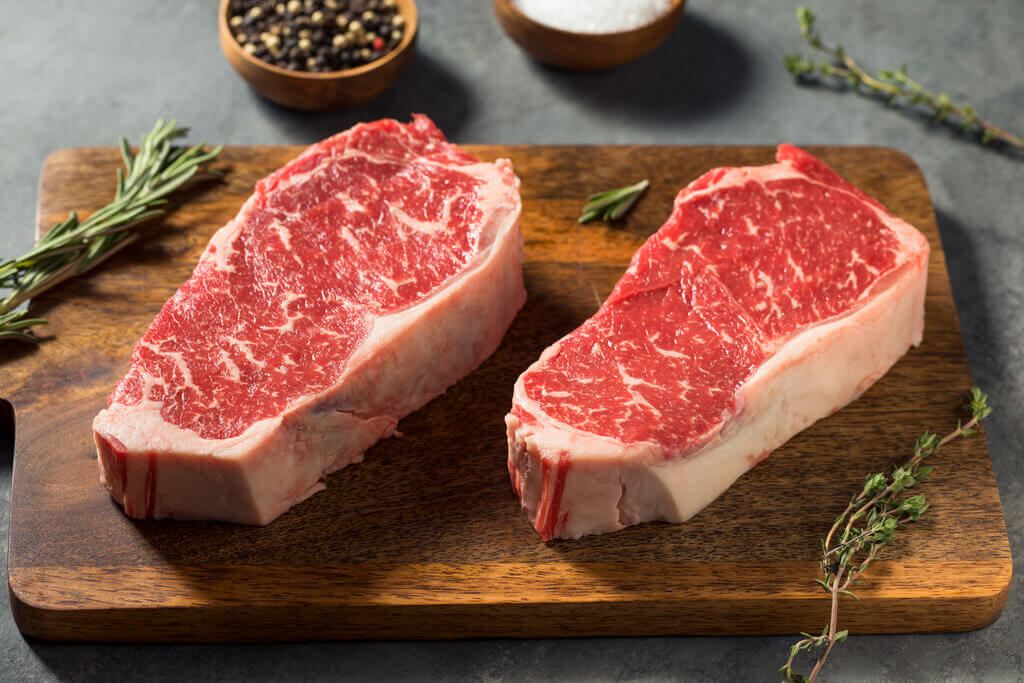
- Boasts a soft texture and a good amount of marbling
- Ideal for pan searing
Also known as New York or a Kansas City strip, the strip steak is cut from the short loin subprimal where the most tender beef cuts are found such as the ribeye steak. However, if we compare New York strip vs ribeye steak, the New York strip has a lower amount of marbling than ribeye. Nonetheless, it is yet another premium cut of beef with a delicate texture and rich beef flavor.
You can grill this beef cut and it will taste exquisite. But the best way to cook strip steak is on the stovetop. Strip steaks are the ideal beef cut for pan-searing as they are thicker and have enough fat. When cooked, they retain their tenderness yet are a bit chewy – providing a great eating experience.
Bottom Sirloin Steak
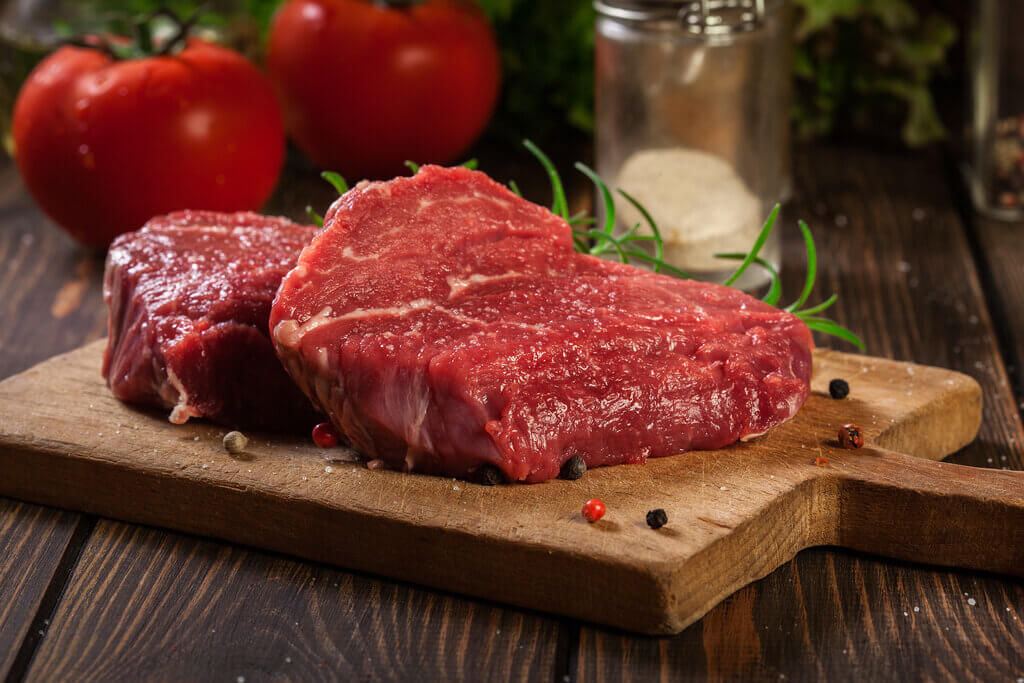
- Affordable steak cut
- Perfect for roasts, stews, and sandwiches
Among the three cuts of sirloin (top sirloin, bottom sirloin, and the rear part of the tenderloin), the bottom sirloin is not as suitable for grilling as the other two. The bottom sirloin, located in the upper hip section of the cow, can be tough, chewy, and chunky. Consequently, bottom sirloin steak is not used as much as the other sirloin cuts.
However, that’s not to say we should completely ignore this affordable steak cut. Thinking of ways to uncover the juiciness of a tough steak like the bottom sirloin? The secret is simple: it is all about how you prepare and cook it! By and large, this beef cut may not be ideal for grilling, but it can be used for stews and sandwiches. This steak cut also produces the best roasts!
Flank Steak
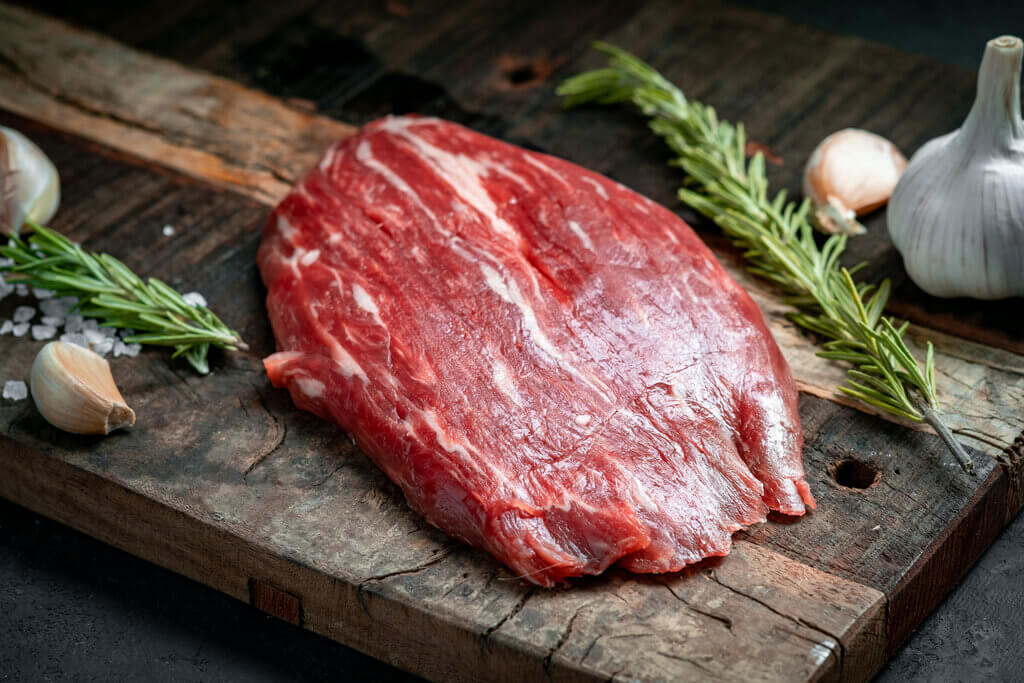
- Has many connective tissue and muscle fibers
- Has a tough texture
- Can be flavorful and tender when prepared and cooked properly
You can find flank steak in the cow’s lower chest or abdominal muscle, just below the loin and sirloin. Also called jiffy steak or London broil, flank steaks contain plenty of connective tissue and muscle fibers. That explains its tough texture, which is quite similar to skirt steak. Although when speaking of the skirt steak vs. flank steak debacle, you should know that the former is a little tougher than the latter.
Despite its toughness, flank steaks taste exquisite when properly cooked. Grilling them over high heat is the best way to unravel their flavor. Although, braising them, cooking via the sous vide method, or pan-searing them on a cast-iron skillet can do the trick just as well. You should also soak these beef cuts in a flavorful marinade before cooking them to further tenderize the meat. Slice it against the grain if you want a better eating experience.
Usually enjoyed in thin strips, this piece of meat also goes perfectly in fajitas and stir-fry recipes. This tough steak cut is also perfect for this London broil recipe. Marinated and broiled on high heat, flank steak will come out juicy and tender. Not to mention, such cuts of steak do not break the bank!
Skirt Steak
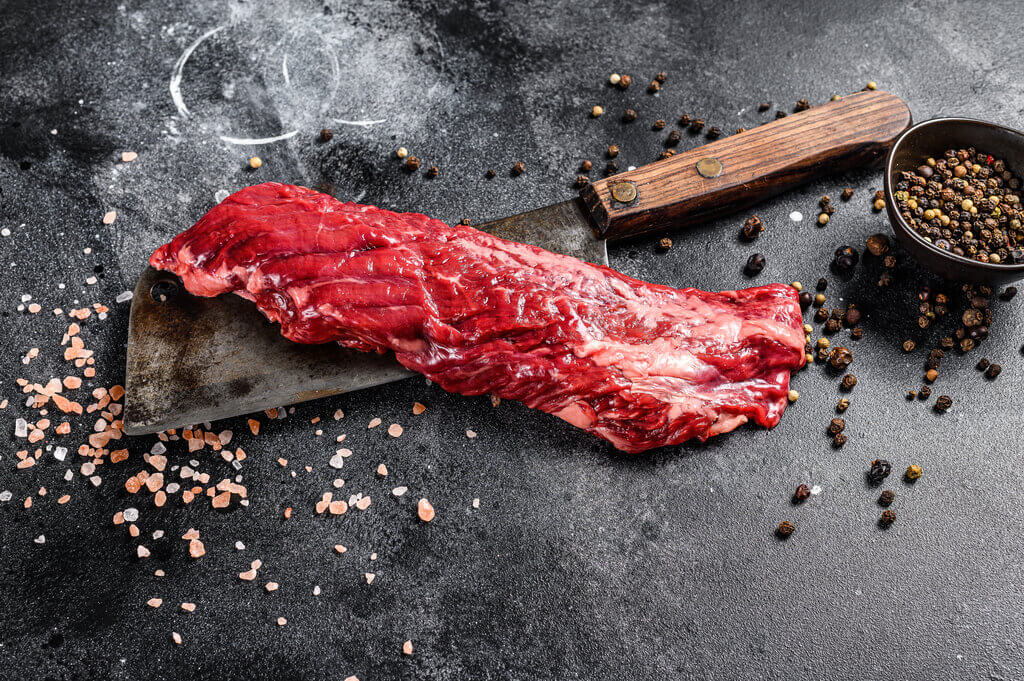
- Contains lots of tough fibers
- Has a rich, beefy taste
Skirt steak, a long and thin piece of meat, is a beef cut found in the diaphragm muscles of the cow. Akin to flank steak, as we have mentioned earlier, it has lots of tough fibers. Hence, it is among the tough beef cuts in the world of steaks. The good news is, skirt steaks, despite their toughness, are among the most flavorful.
Pro-tip: cook it the right way to achieve its most tender texture. Versatile as it is, you can slow cook, braise, or cook skirt steak quickly over high heat. It also makes for a great steak choice when making fajitas.
Round Steak
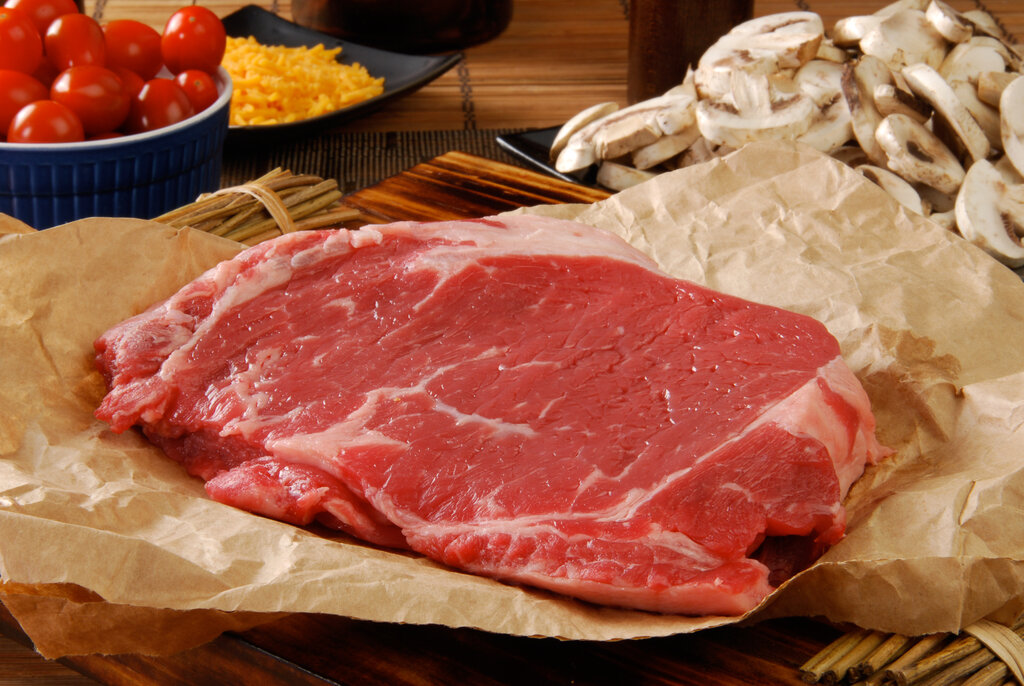
- Divided into three steak cuts
- Tough and lean
- Best for slow moist-heat cooking methods
A beef cut situated in the rear leg of the cow, a round steak is divided into three more parts: the top, the tip, and the bottom. Being located in an area typically used for movement, round steaks are naturally lean and less tender. But while they lack the texture element that we all want in a steak, round steaks or beef rounds are actually versatile thick beef cuts that you can use for delicious deli roasts and stir-fries. And with the help of various dry spices, you can elevate their flavor too!
Since they are on the leaner side, marinating round steaks or using a meat mallet will be especially helpful in tenderizing them. Meanwhile, slow moist-heat cooking methods, like braising, are among the best cooking methods to enhance their overall flavor. With these beef cuts, you can also have a fancy and flavorful steak night as they are reasonably priced.
Vacio Steak
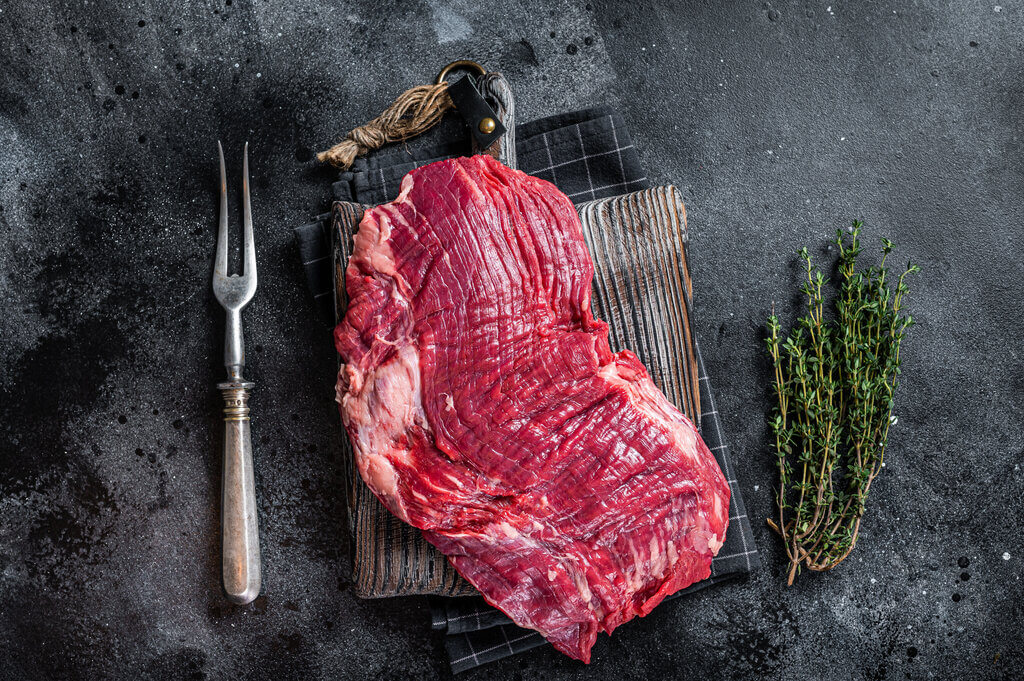
Vacio steak (pronounced as “vah-SEE-oh”) or the flap steak is a muscle found around the cow’s belly. It is a popular steak cut in Argentina and is also called bavette in France. This particular beef cut, albeit one of the flank primal cuts, is different from flank steaks. This flap-shaped steak, weighing between four and five pounds, is the perfect steak choice if you’re cooking for a crowd.
Vacio steaks are often great cuts for grilling or an asado, as Argentinians would call it. You can season the meat with salt before cooking to enhance its flavor. Then, serve with a chimichurri sauce for a more delightful steak experience!
How to Choose the Best Cut of Steak
Sure, you have found a slew of steak recipes on the Internet. You have memorized the set of instructions by heart. But for the record, choosing the best cut of steak is another story. No matter which beef cut you buy, here are some things that might help you single out good quality steaks:
Marbling
Don’t shy away from steaks with plenty of white lines running through them. Those flecks of fat are called marbling, and they are responsible for your steak’s excellent texture and flavor. If the meat has more marbling, it will most likely be more tender and more flavorful. However, steaks with more marbling are mostly more expensive. Then again, select the one with just the right amount of marbling if you don’t want your steak to be excessively fatty.
Grade
USDA uses a grading system to indicate the overall quality of steaks. They determine the grade based on a few factors: the degree of marbling, maturity or age of the animal, and more. Here are some of the beef grades you should be aware of:
- Prime – Prime-grade beef is considered the highest in terms of quality. Such meat usually comes from young cattle and has lots of marbling. Prime beef is widely available in fancy hotels and restaurants.
- Choice – A high-quality beef, choice-grade steaks are considered average. They are juicy, delicious, and have less marbling than prime-grade steaks.
- Select – Select beef is considered of the lowest quality in the matter of texture and flavor. Steaks that fall under this grade have less marbling than prime and choice steaks and are less juicy. Nonetheless, you can still have the best steak experience, provided you cook them properly.
Thickness
When buying steaks, it is also necessary to look at their thickness. Remember that thinner cuts are a bit tricky to cook. Sure, you can cook them on the grill or in the oven, but note that they also tend to overcook. If it is too thick, chances are the inside might be undercooked. Opt for steaks that are at least 1-inch thick as they are much easier to prepare.
Price
On the whole, the most expensive ones are more well-marbled than the cheap ones. Even so, it is best to examine each cut of steak to make sure you handpick the best meat for your recipe.
Aging
Beef aging refers to a process wherein the beef is kept and stored after slaughter. Beef is aged in two ways: wet and dry. When wet-aging beef, the meat is simply placed in vacuum bags and kept in the refrigerator. On the other hand, dry-aging is when you leave the beef uncovered in a refrigerated room. Dry-aged beef, in essence, has a more intense palate versus beef that undergoes a wet-aging process.
Best Steak Recipes to Try
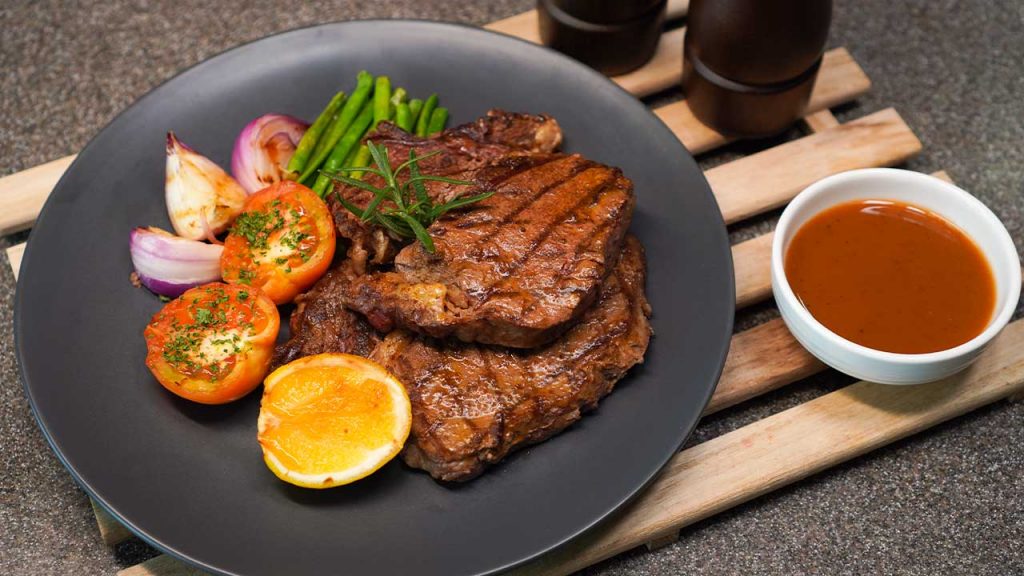
Whatever the occasion is (whether a regular cookout party or a fancy dinner), these steak recipes are bound to impress your guests.
- Outlaw Ribeye Steak – Have a fancy steak dinner at home with this simple yet utterly delicious recipe! To make a juicy steak bursting with smoky flavors, season the meat with paprika and cayenne pepper before grilling.
- Grilled Beef Tenderloin – Bring beefy flavors to another level by slathering the tenderloin steaks with a flavorful steak rub. After cooking the meat to medium doneness, top it with a sweet-tangy dates essence.
- The Capital Grille Filet Mignon – Adding fig essence and demi-glace sauce to grilled filet mignon makes it even more succulent. Serve this juicy steak with tender cipollini onions and wild mushrooms on top!
- Flat Iron Steak and Spinach Salad – A mix of meat and greens make for an elegant weeknight dinner. Enter this flat-iron steak recipe that consists of appetizing steak over a bed of spinach salad. Make it even more delightful and serve with wine and Italian salad dressing on top!
- Strip Steak with Red Wine Cream Sauce – Strip steaks are downright irresistible when smothered with a red wine cream sauce. This steak meal boasts wonderful flavors, thanks to three tasty ingredients: heavy cream, red wine, and Dijon mustard.
- Grilled Steak Fajitas – The secret to mouthwatering grilled steak fajitas? Marinate the beef with chili powder, oregano, and Worcestershire sauce. When ready to serve, fill the tortillas with the steak and your chosen toppings.
- Eye of Round Steak – Prepare a restaurant-worthy steak dinner with this easy-to-prepare steak recipe. Season the round steaks before searing and cook the meat with butter, a few sprigs of fresh rosemary, and crushed garlic cloves so it will taste fabulous.
